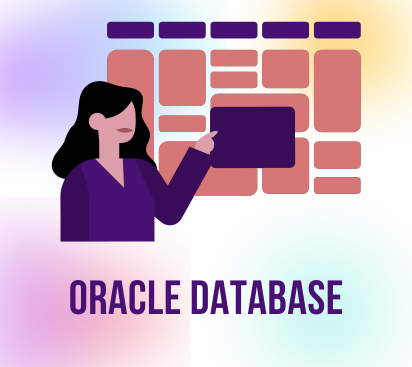

Short Overview
An Oracle Database (aka Oracle RDBMS) is a collection of data organized by type with relationships being maintained between the different types. The primary purpose of a database is to store and retrieve related information.
- Introduction of Oracle
- What is Oracle ?
- What is OORDBMS ?
- History of Oracle
- Editions of Oracle
- Introduction of SQL
- Oracle v/s SQL
- History of SQL
- What is PL - SQL ?
- Types of SQl Command
- Data Type in Oracle
- About Oracle 11g
- Downloading and Installation of Oracle 11g express edition
- Creating new user
- The ALTER TABLE Command
- Uses Of ALTER TABLE Command
- Adding / Modifying Columns
- Deleting columns
- Rename Column/ Table
- Truncate table command
- Drop table command
- Introduction To DML Commands
- The INSERT Command
- Different Types Of INSERT Commands
- The UPDATE Command
- Introduction To DELETE Command
- DELETE Vs TRUNCATE
- Introduction To DQL Command
- The SELECT Command
- Varieties Of SELECT Commands
- Operators In Oracle
- Some Queries Based On Operators
- Pattern Matching
- Functions In Oracle
- The DUAL Table
- Various DATE Functions
- Date Arithmetic
- Introduction To STRING Functions
- Various STRING Functions Of Oracle
- Introduction To NUMERIC Functions
- Various NUMERIC Functions Of Oracle
- Introduction To CONVERSION Functions
- The TO_CHAR() Function
- The TO_NUMBER() Function
- The TO_DATE() Function
- Introduction To GROUP Functions
- Types Of GROUP Functions
- Introduction To MISCELLANEOUS Functions
- Types Of MISCELLANEOUS Functions
- Introduction To MISCELLANEOUS Functions
- Types Of MISCELLANEOUS Functions
- Introduction To GROUP BY Clause
- Using WHERE With GROUP BY
- Using HAVING With GROUP BY
- WHERE v/s HAVING
- Introduction To ORDER BY Clause
- Sorting Order Of ORDER BY
- Sorting On Multiple Columns
- Behaviour Of DISTINCT And NULL In ORDER BY
- Outer Join
- Types Of Outer Joins
- ANSI Syntax For Join
- Natural Join
- Non-Equi Join
- Natural Join
- Non-Equi Join
- Types Of SubQueries
- Single Row SubQuery
- Multi Row SubQuery
- SubQueries & Null
- SubQueries & Order By
- Correlated SubQueries
- MultiColumn SubQueries
- Introduction To ROWNUM
- Internal Working Of ROWNUM
- Introduction To Set Operators
- Types Of Set Operators
- Restrictions On Set Operators
- Introduction To Constraints
- Types Of Constraints
- Applying Constraints At The Column Level
- Table Level Constraints
- Applying Constraints Using Alter Table
- Using The Default Clause
- Renaming Constraints
- Disabling/Enabling Constraint
- Removing Constraints
- Introduction To Sequences
- Syntax Of Sequence
- Sequence Attributes
- Using A Sequence
- Connecting Sequence With Table
- Removing Sequence
- Obtaining Details Of Sequence
- Introduction To View
- Advantages Of View
- Types Of View
- Making Changes In The View
- Using Special Clauses With The View Restrictions On A Single View
- Compiling A View
- Introduction To JOIN VIEW
- Creating A JOIN VIEW
- Concept Of Key Preserved Table
- DML Operations Allowed On Join View
- Getting View Details
- Removing A View
- General Restrictions On View
- Introduction To Indexes
- Benefits Of Indexes
- Types Of Indexes
- Single Index And Composite Index
- Implicit Index And Function Based Index
- Removing Indexes
- Obtaining Details Of Index
- Introduction To DCL Commands
- Understanding Schema
- SYS and SYSTEM
- Creating New User
- Concept Of TableSpace
- Unlocking Users
- Dropping Users
- Understanding Privileges
- System Privileges
- Object Privileges Grant Command
- Revoke Command
- Roles
- Removing Roles
- Obtaining Details Of Privileges
- Obtaining Details About Roles
- Types Of Synonyms
- Dropping And Renaming Synonyms
- Commit
- Rollback
- Savepoint
- Advantages Of PL-SQL
- PL-SQL Architecture
- Data Types In PL-SQL
- Variable Declaration & Assignment
- Constants & Comments
- Operators
- Loops In PL-SQL
- Basic Loop
- While Loop
- For Loop
- Executing SQL From PL
- Executing INSERT,UPDATE &DELETE
- Executing SELECT INTO
- Cursor In PL-SQL
- Types Of Cursors
- Implicit Cursor
- Explicit Cursor
- Cursor For Loop
- Parameterized Cursor
- Examples
- Introduction To Exceptions
- Handling Exceptions
- Predefined Exceptions
- Pragma
- User Defined Excption
- Resuming After Exception
- Using Raise_Application_Error
- Introduction To Procedures And Functions
- Benefits
- Procedure V/s Functions
- Syntax Of Creating A Procedure
- Parameter Types
- Creating Functions In PL-SQL
- Calling Functions
- Calling Procedures/Functions From SQL Prompt
- Obtaining Details Of Procedures And Functions
- Dropping Procedures And Functions
- Production of packages
- Dropping packages
- Introduction To Trigger
- Benefits of Trigger
- Components Of A Package
- Generating Primary Key
- New Way Of Auto Generating Primary Key
- Restrictions
- Statement Level Trigger
- Creating A Statement Level Trigger
- Instead Of Trigger
- Removing/ Disabling/Enabling A Trigger
- Collections In PL-SQL
- Types Of Collections
- Exception Handling Syntax
- Introduction To Associative Array
- Using Associative Array
- Methods Of Associative Arrays
- Declaring & Initializing
- Adding Elements
- Accessing Elements
- PL-SQL Object Oriented Programming
- What Are Object Types ?
- Creating And Initializing Object Types
- Adding Constructor
- Introduction To Oracle 12c
- Understanding Cloud Based MultiTenant Architecture
- Container Database & Pluggable Databases
| Oracle Database Lecture - 1 | Preview |
| Oracle Database Lecture - 2 | Preview |
| Oracle Database Lecture - 3 | Preview |
| Oracle Database Lecture - 4 | Preview |
| Oracle Database Lecture - 5 | Preview |
From Basics to Advanced Oracle Database
- Basics to Advanced: Master Oracle Database from foundational concepts to advanced database management techniques.
- Zero to Hero: Transform from a beginner to an expert in Oracle Database administration and development.
- Comprehensive Coverage: Understand everything from database architecture, SQL, and PL/SQL to advanced topics like performance tuning, backup and recovery, and data security.
Live Lectures
- 50 Hours: Participate in live, interactive sessions with experienced Oracle Database professionals.
- Hands-on Practice: Gain practical experience by working on real-world Oracle Database scenarios during live sessions.
- Practice Sessions: Engage in dedicated practice sessions to master Oracle Database management and development.
Doubt Solving
- Unlimited Doubt Clearing Sessions: Get all your questions answered with support from expert instructors.
Test Series and Assignments
- Topic-Wise Test Series: Assess your understanding with tests after each major Oracle Database topic.
- Assignments: Apply your learning through practical assignments, including database design, SQL queries, and PL/SQL programming.
Lecture Notes
- Detailed Notes: Access comprehensive notes for every lecture, covering essential Oracle Database concepts and best practices.
Certifications
- Oracle Database Completion Certificate: Earn a certificate for mastering Oracle Database management and development.
- System With Minimum I3 Processor Or Better
- At Least 4 Gb Of Ram
Ready to kick-start your career?
Join Us Now Join Us Now



